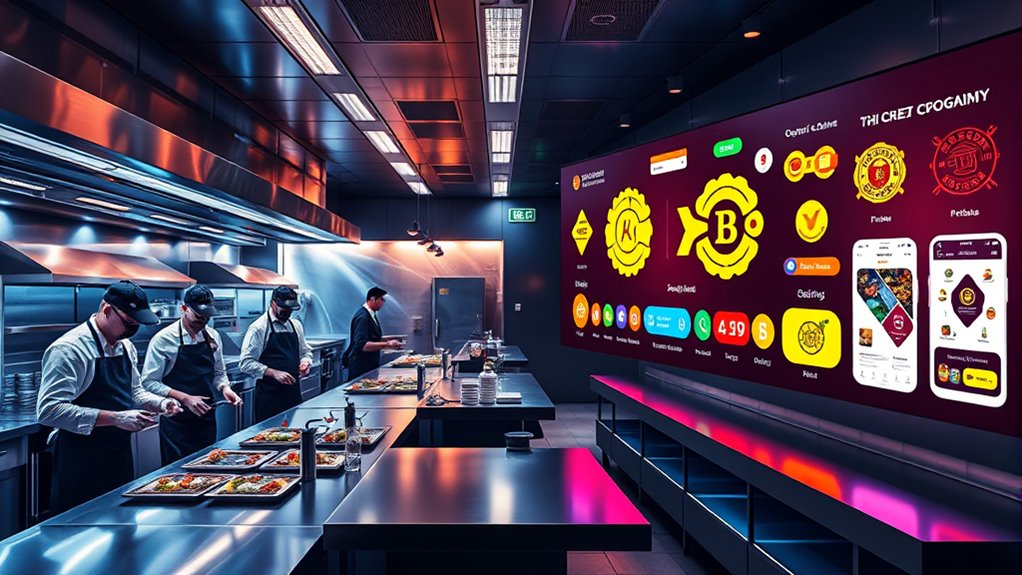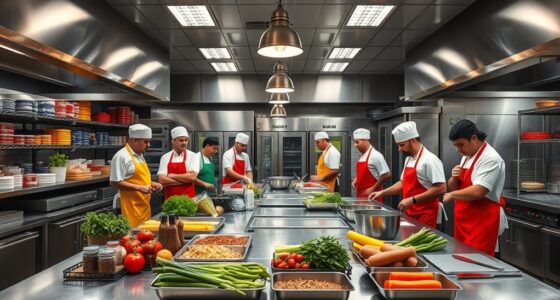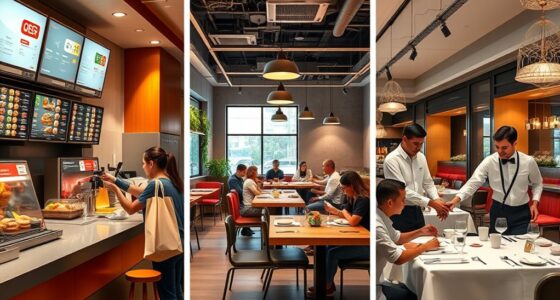Ghost kitchens are dedicated spaces that prepare multiple brands for delivery or takeout, focusing on operational efficiency, while virtual brands exist solely online, emphasizing branding and marketing without physical storefronts. Both leverage delivery apps to reach customers and reduce costs, but ghost kitchens provide the cooking space, and virtual brands rely on online presence to attract orders. Exploring these models reveals how they’re reshaping the food industry—keep going to discover more about their unique roles.
Key Takeaways
- Ghost kitchens are physical, shared spaces serving multiple brands, while virtual brands exist solely online without physical storefronts.
- Ghost kitchens focus on operational setup and infrastructure; virtual brands emphasize branding, marketing, and online presence.
- Multiple virtual brands can operate within a single ghost kitchen to diversify revenue streams and reduce costs.
- Ghost kitchens handle food preparation and delivery logistics; virtual brands primarily manage branding and digital marketing strategies.
- Both models reduce overhead costs and enable rapid market entry, but ghost kitchens provide the operational backbone for virtual brands.
Defining Ghost Kitchens and Virtual Brands

Ghost kitchens and virtual brands are reshaping the food delivery landscape, but they are not the same thing. Ghost kitchens are dedicated cooking spaces without dine-in facilities, serving multiple restaurants or brands from a single location. They focus purely on preparing food for delivery or takeout, often sharing kitchen space to reduce costs. Virtual brands, meanwhile, are brands created solely for online ordering, without a physical storefront. They may operate out of ghost kitchens or existing restaurants, offering a specific cuisine or concept designed to appeal to digital customers. While both leverage delivery channels, ghost kitchens are about the facility, and virtual brands are about the branding and menu. Understanding this distinction helps you see how they influence modern foodservice. Additionally, some ghost kitchens are used to develop new brands or concepts, allowing restaurateurs to test the market without a permanent physical location.
Operational Structures and Setup

The operational structures of ghost kitchens and virtual brands are designed for efficiency and flexibility. You typically set up a centralized kitchen space that can handle multiple brands or menus, maximizing space utilization. This setup allows you to streamline food prep and reduce overhead costs since you don’t need a storefront. Staff are often cross-trained to prepare various dishes, increasing flexibility during busy periods. Technology plays a vital role, with online ordering platforms and kitchen management software helping you coordinate orders seamlessly. Delivery logistics are usually outsourced or managed through third-party services, allowing you to focus on operations. Overall, this setup enables you to adapt quickly to changing demand, scale efficiently, and operate with minimal physical footprint. Incorporating high-quality equipment can further optimize your kitchen’s performance and output.
Branding Strategies and Customer Engagement
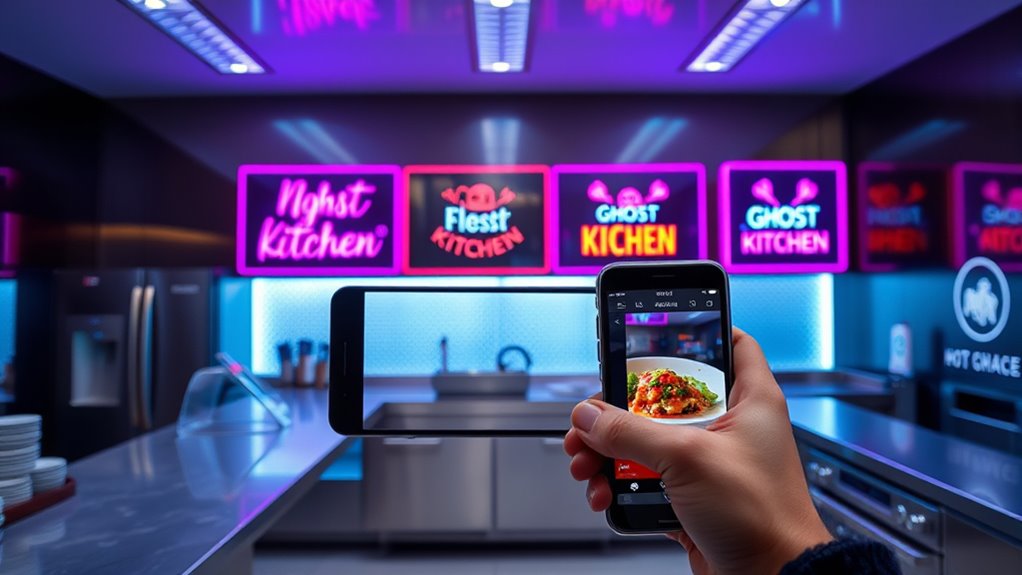
Effective branding strategies and customer engagement are essential for standing out in the crowded virtual food space. You need to create a memorable brand identity that resonates with your target audience, whether through a compelling logo, consistent messaging, or unique packaging. Building trust and loyalty requires active interaction—responding promptly to reviews, engaging on social media, and offering personalized experiences. Use storytelling to connect emotionally with your customers, sharing your brand’s values or behind-the-scenes content. Promotions, loyalty programs, and limited-time offers can foster repeat business. Remember, engaging customers isn’t just about the food; it’s about creating a connection, making them feel valued and understood. Incorporating branding elements that reflect your unique identity can significantly enhance recognition and loyalty. When you prioritize authentic engagement, your virtual brand can build a loyal community that champions your offerings.
Menu Development and Adaptation
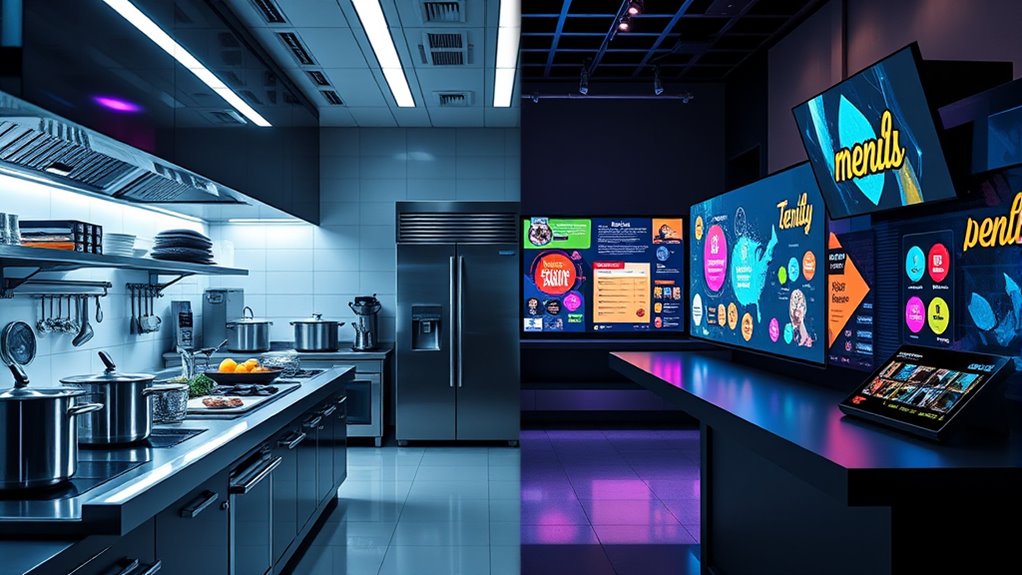
Your menu should be flexible enough to adapt quickly to changing tastes and trends. Regional variations allow you to cater to local preferences and stand out in different markets. Embracing innovation and experimentation keeps your offerings fresh and competitive. Incorporating cozy textiles and authentic decor themes can also inspire menu creativity and elevate the overall customer experience.
Flexibility in Offerings
How quickly can a ghost kitchen or virtual brand change its menu to meet shifting customer tastes? It depends on your operational setup. Ghost kitchens often have streamlined processes, allowing rapid updates since they usually work with a centralized kitchen and digital ordering system. Virtual brands, built on digital platforms, can tweak menus instantly by updating online listings without physical changes. This agility lets you introduce new dishes, remove underperformers, or adapt flavors promptly. You’re not limited by traditional restaurant constraints like shelf life or ingredient sourcing for physical menus. Instead, you can respond swiftly to trends, seasonal demands, or customer feedback, keeping your offerings fresh and relevant. Flexibility in menu development becomes a key advantage, enabling you to stay competitive and meet evolving preferences seamlessly. Additionally, leveraging cybersecurity measures ensures your digital platforms remain protected while making rapid menu changes.
Regional Menu Variations
Regional menu variations are vital for ghost kitchens and virtual brands aiming to meet local tastes and preferences. You need to adapt your offerings to reflect regional ingredients, flavors, and dining habits. This customization helps you resonate with local customers and stand out from competitors. Analyzing regional preferences allows you to tweak existing dishes or introduce new items that appeal specifically to your target market. You might incorporate local spices, popular regional ingredients, or traditional dishes with a modern twist. This approach not only boosts customer satisfaction but also increases sales by providing a personalized experience. Remember, understanding regional culinary trends and cultural nuances is key to designing menus that truly connect with nearby communities. Adaptation is essential for building loyalty and expanding your virtual footprint effectively. Embracing cultural insights can further refine your menu development to better suit regional tastes.
Innovation and Experimentation
Innovation and experimentation are essential for keeping menu offerings fresh and appealing in the competitive landscape of ghost kitchens and virtual brands. You need to stay agile, regularly testing new dishes or flavors to meet evolving customer tastes. This approach allows you to identify what resonates and what doesn’t, minimizing risk and maximizing appeal. Leveraging data analytics, customer feedback, and market trends helps guide your menu development. You can quickly adapt by introducing limited-time offers or seasonal items, creating excitement and exclusivity. Experimenting with different cuisines, presentation styles, or ingredient swaps keeps your menu dynamic. Incorporating a creative mindset into your process encourages continuous innovation and helps you stay ahead of industry trends. Ultimately, continuous innovation ensures your brand stays relevant, attracts new customers, and fosters loyalty among existing ones.
Revenue Streams and Business Models
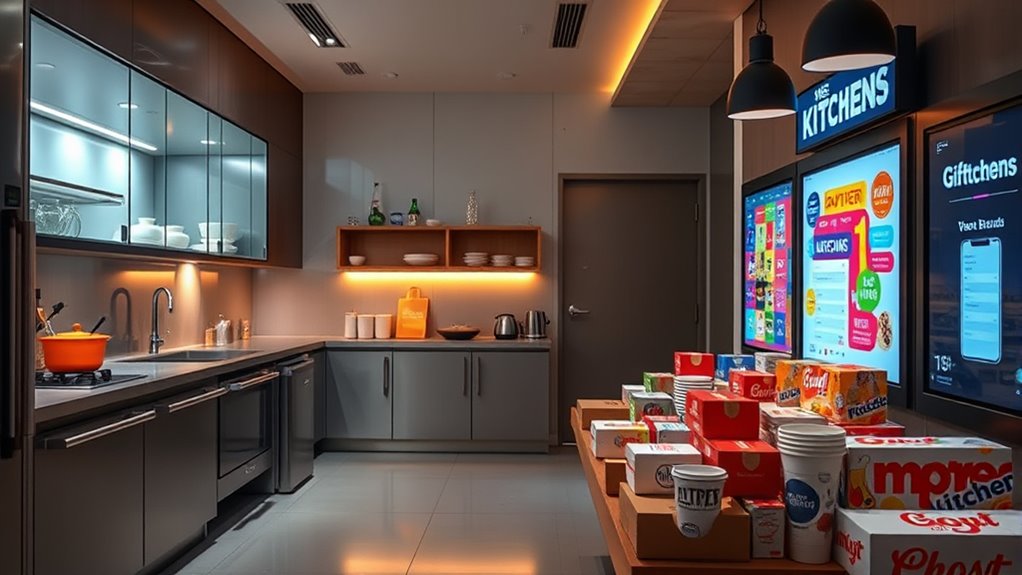
Ghost kitchens and virtual brands generate revenue primarily through online orders placed via third-party delivery platforms or their own apps. Your business model centers on minimizing overhead while maximizing order volume. You might charge delivery fees or mark up menu prices to increase profit margins. Many virtual brands rely on partnerships with delivery apps, earning commissions on each sale. Some also explore subscription services or loyalty programs to boost customer retention. Additionally, you can create multiple virtual brands under a single kitchen to diversify revenue streams without significant additional investment. Overall, the focus is on digital sales channels, leveraging technology to reach customers efficiently. Your success depends on optimizing online marketing, menu design, and delivery logistics to ensure steady revenue flow. Incorporating traffic generation techniques like SEO and social media marketing can significantly enhance visibility and order volume.
Benefits and Challenges for Stakeholders
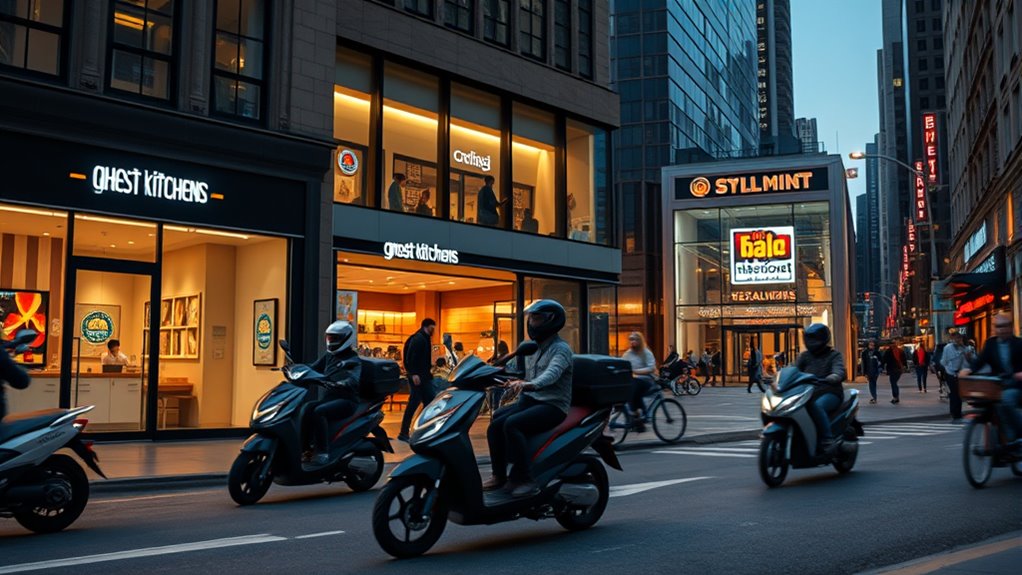
As a stakeholder, you can benefit from reduced operational costs and new market expansion opportunities with ghost kitchens and virtual brands. However, you also face risks like diminished brand visibility and increased competition. Balancing these advantages and challenges is key to maximizing your success in this evolving landscape. Incorporating effective branding strategies can help maintain customer loyalty and stand out amidst growing competition.
Operational Cost Impacts
While virtual brands often reduce upfront investment, they also considerably impact operational costs for stakeholders. You may see lower expenses on physical storefronts and décor, but managing multiple brands from a single kitchen can increase staffing complexity. Additionally, implementing fraud detection measures is essential to safeguard online transactions and protect revenue. Delivery logistics become more streamlined, reducing transportation expenses. Marketing costs can rise as you promote each virtual brand individually. Quality control and consistency challenges may lead to increased waste and rework.
Brand Visibility Risks
Managing multiple virtual brands in a single kitchen can complicate how your customers discover and recognize each one. When brands share the same space, their identities may blur, making it hard for customers to differentiate and remember them. This can weaken brand loyalty and dilute marketing efforts. Additionally, inconsistent branding across platforms can confuse potential diners, reducing order volume. On the upside, virtual brands can target niche markets or limited-time offerings, boosting visibility within specific audiences. However, the challenge lies in maintaining distinct, compelling identities without overwhelming your marketing channels. If not managed carefully, brand confusion can lead to decreased trust and lower customer retention. Ultimately, balancing brand differentiation with operational efficiency is key to minimizing visibility risks.
Market Expansion Opportunities
Market expansion through ghost kitchens and virtual brands offers significant benefits for stakeholders by opening new customer segments and geographic areas without the high costs of traditional brick-and-mortar locations. This approach allows you to test markets quickly, adapt menus regionally, and reach customers who prefer delivery or takeout. However, expanding this way also presents challenges, like maintaining consistent quality across locations and managing increased logistical complexity. You must also navigate local regulations and build brand recognition in unfamiliar areas.
- Lower startup costs enable faster market entry
- Flexibility to experiment with different menus
- Increased reach with minimal physical footprint
- Potential brand dilution if quality isn’t maintained
Future Trends and Industry Impact
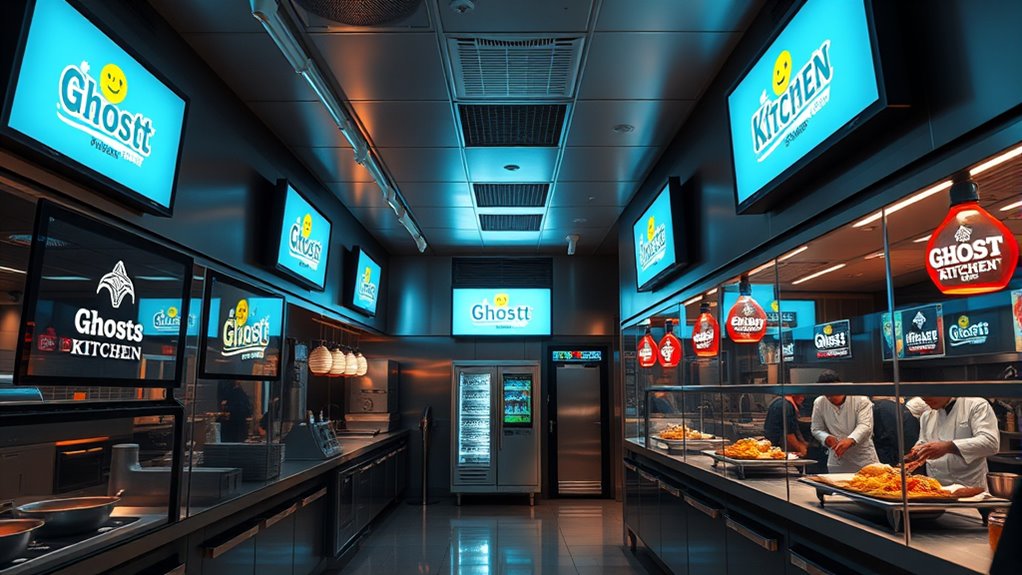
As the food delivery landscape continues to evolve, future trends suggest that ghost kitchens and virtual brands will play an increasingly significant role in shaping industry dynamics. You’ll see more brands operating exclusively online, reducing overhead costs and increasing agility. Technology will drive better data analytics, enabling you to tailor menus and marketing strategies precisely. Automation and AI are expected to streamline operations, improving efficiency and delivery times. Industry impact will include heightened competition, forcing traditional restaurants to adapt or partner with virtual concepts. Consumer preferences for convenience and variety will continue to grow, making virtual brands more mainstream. Overall, these trends will reshape how you access, experience, and perceive food delivery, pushing the industry toward a more innovative and flexible future.
Frequently Asked Questions
How Do Ghost Kitchens Impact Local Restaurant Employment?
You might wonder how ghost kitchens affect local restaurant employment. They often reduce traditional restaurant jobs because they operate without dine-in spaces, relying heavily on delivery and takeout. While they can create new roles in logistics, cooking, and management, these jobs may not fully replace the ones lost from closed or downsized dine-in establishments. Overall, ghost kitchens shift employment patterns, potentially decreasing full-service restaurant staff but increasing roles in delivery and kitchen operations.
Can Virtual Brands Operate Across Multiple Delivery Platforms Simultaneously?
You might think managing multiple delivery platforms is complex, but virtual brands are designed for that. They can operate efficiently across various platforms simultaneously, expanding your reach without extra storefronts. This flexibility lets you target different customer segments and increase sales. With the right tech tools, you control orders from all platforms in one system, making it easier to grow your virtual brand presence without overextending yourself.
What Legal Regulations Specifically Target Ghost Kitchens and Virtual Brands?
You should know that legal regulations for food businesses vary by location, but generally, they include health and safety standards, licensing, and zoning laws. Ghost kitchens and virtual brands must adhere to food safety regulations, obtain proper permits, and follow delivery platform rules. Some areas also require transparency about ownership and operation, especially for virtual brands. Staying compliant means keeping up with local laws and maintaining high safety standards.
How Do Customer Perceptions Differ Between Ghost Kitchens and Virtual Brands?
Did you know 60% of consumers prefer dining at established brands over new ones? When it comes to perceptions, you might see virtual brands as less trustworthy because they lack physical storefronts, while ghost kitchens often face scrutiny over food quality. You tend to view virtual brands as innovative but less reliable, whereas ghost kitchens might seem more familiar but less transparent. Your trust depends on brand reputation and transparency.
Are There Significant Environmental Sustainability Concerns With These Models?
You might wonder if these food delivery models raise environmental concerns. They can, since ghost kitchens often operate multiple units close together, leading to increased energy use and waste. Virtual brands may also contribute to packaging waste and delivery emissions. While they can improve efficiency by reducing dine-in space, you should consider their impact on urban congestion, resource consumption, and sustainability efforts to make informed choices about supporting these models.
Conclusion
Ultimately, whether you’re exploring ghost kitchens or virtual brands, understanding their unique dynamics can deliver dynamic growth. By balancing bold branding with smart strategies, you can capitalize on culinary creativity and customer connection. Embrace evolving trends, harness innovative setups, and stay adaptable to achieve ambitious objectives. Remember, success in this space depends on smart strategies, swift shifts, and staying ahead of the curve—so seize the future and step confidently into the culinary cloud!
